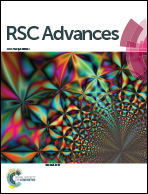Facile fabrication of AIE/AIEE-active fluorescent nanoparticles based on barbituric for cell imaging applications†
Abstract
Four barbituric derivatives (1–4), were synthesized with obvious aggregation induced emission (AIE) or aggregation induced emission enhancement (AIEE) behaviors. The optical properties in different states and the mechanisms of the enhanced emission of 1–4 were investigated. We found that there were a large number of globular or blocky nanoparticles with average diameters from 229 to 394 nm in tetrahydrofuran (THF)/water solutions when the water fraction (fw) was 90%. The single crystal data of 2 and 4 reveal that multiple intermolecular interactions restrict the intramolecular motions, and promote the formation of a herringbone arrangement (4), thus permitting intense emission in the aggregate state. In addition, the frontier molecular orbital energy and band gap calculated by density functional theory (DFT) are consistent with the experimental results. Compound 4 is cell-permeable: upon entering the live cells, the dye molecules can accumulate in the lysosomes and turn on the fluorescence.



 Please wait while we load your content...
Please wait while we load your content...